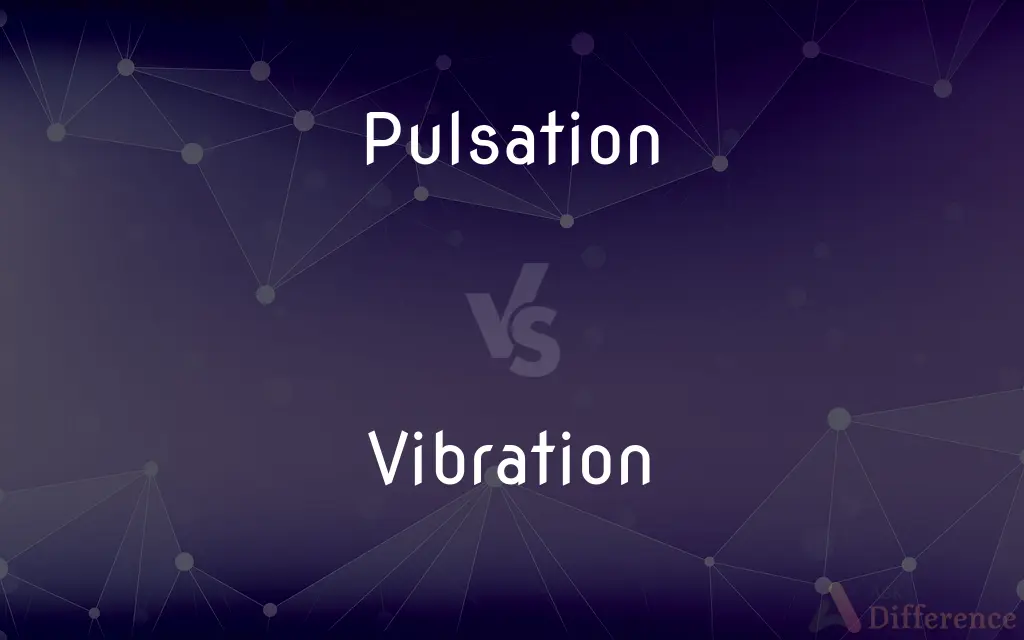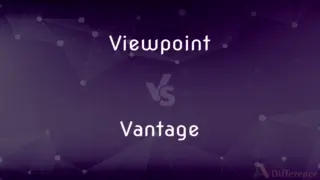Pulsation vs. Vibration — What's the Difference?
Edited by Tayyaba Rehman — By Maham Liaqat — Updated on April 3, 2024
Pulsation refers to a periodic expansion and contraction, often in a fluid context, while vibration is the rapid back and forth movement of an object.

Difference Between Pulsation and Vibration
Table of Contents
ADVERTISEMENT
Key Differences
Pulsation involves the rhythmic expansion and contraction of an object or medium, often seen in fluid dynamics where it describes the movement of gases or liquids in a cyclical manner. This can be observed in the operation of piston pumps or the human cardiovascular system, where blood flow is regulated by the heart's pulsations. On the other hand, vibration refers to the oscillation or the rapid back and forth movement of an object around an equilibrium point. It is a physical phenomenon encountered across a wide range of contexts, from the vibrating strings of a guitar producing sound to the structural vibrations of a building during an earthquake.
Pulsations are generally characterized by a slower, more measured pace and are often involved in processes that require the transfer of fluids or gases at specific rates. For example, the pulsating action of a heart pumping blood through the circulatory system is critical for maintaining life, illustrating pulsation’s role in periodic, controlled movements. Vibrations, however, occur at much higher frequencies and are not necessarily periodic. They can result from a variety of sources, such as mechanical imbalances, external forces, or natural phenomena. The effects of vibrations can range from beneficial, as in the case of therapeutic medical devices, to potentially harmful, leading to material fatigue and structural damage.
In terms of energy transmission, pulsation in fluids can lead to pressure surges or drops within a system, which engineers must carefully manage to avoid damage to pipes and other components. This is crucial in industries such as oil and gas, where the pulsation of fluids through pipelines can affect the entire operation. Vibration, by contrast, involves the transfer of kinetic energy from one part of a system to another, which can be harnessed for various applications, including the generation of electricity in piezoelectric devices or the analysis of material properties through vibrational spectroscopy.
Monitoring and control strategies for pulsation and vibration also differ significantly due to their distinct natures. Pulsation damping devices, such as accumulators or pulsation dampeners, are used in fluid systems to smooth out the flow and minimize pressure variations. In contrast, vibration control involves the use of dampers, isolators, and absorbers to reduce or eliminate unwanted vibrations in machinery, vehicles, and buildings, thereby protecting structural integrity and improving comfort and performance.
Despite their differences, both pulsation and vibration play essential roles in engineering and physics. Understanding their characteristics and effects allows for the optimization of systems ranging from simple mechanical devices to complex industrial operations. It underscores the importance of these phenomena in a wide array of applications, highlighting the diverse ways in which periodic movements and oscillations contribute to both natural and man-made environments.
ADVERTISEMENT
Comparison Chart
Definition
Periodic expansion and contraction
Rapid back and forth movement
Common Contexts
Fluid dynamics, cardiovascular system
Mechanical systems, structural analysis
Frequency
Typically lower
Typically higher
Medium
Often involves fluids (gases, liquids)
Can occur in solids, liquids, and gases
Application Examples
Heartbeat, piston pumps
Guitar strings, earthquake engineering
Compare with Definitions
Pulsation
Periodic Expansion and Contraction.
The pulsation of the heart ensures a steady flow of blood throughout the body.
Vibration
Mechanical Fluctuation.
Engineers measure the vibration of the bridge to assess its structural integrity.
Pulsation
Oscillation in Biological Systems.
The pulsation of jellyfish propels them forward in the water.
Vibration
Rapid Oscillation.
The vibration of the washing machine was loud enough to hear across the house.
Pulsation
Rhythmic Movement in Fluids.
Pulsation in the water pipe causes the fluctuating water pressure in the shower.
Vibration
Physical Phenomenon in Materials.
The vibration of the crystal in the watch keeps accurate time.
Pulsation
Cyclical Variation in Pressure.
The engineer monitored the pulsation in the pipeline to prevent bursts.
Vibration
Back and Forth Movement.
The vibration of the guitar string creates the sound we hear.
Pulsation
Mechanical Repetition in Devices.
The pulsation of the pump helps to evenly distribute chemicals in the pool.
Vibration
Energy Transfer through Oscillation.
The vibration of the earthquake was felt miles away from the epicenter.
Pulsation
The action of pulsating.
Vibration
Vibration is a mechanical phenomenon whereby oscillations occur about an equilibrium point. The word comes from Latin vibrationem ("shaking, brandishing").
Pulsation
A single beat, throb, or vibration.
Vibration
The act of vibrating.
Pulsation
The regular throbbing of the heart, an artery etc. in a living body; the pulse.
Vibration
The condition of being vibrated.
Pulsation
Any rhythmic beating, throbbing etc.
Vibration
A rapid linear motion of a particle or of an elastic solid about an equilibrium position.
Pulsation
Physical striking; a blow.
Vibration
A periodic process.
Pulsation
A single beat, throb or vibration.
Vibration
A single complete vibrating motion; a quiver.
Pulsation
A beating or throbbing, especially of the heart or of an artery, or in an inflamed part; a beat of the pulse.
Vibration
(Informal) A distinctive emotional quality or atmosphere that is sensed or experienced by someone. Often used in the plural
"Miami gives off the same vibrations, the same portent of disaster, but with a difference" (James Atlas).
Pulsation
A single beat or throb of a series.
Vibration
The act of vibrating or the condition of being vibrated.
Pulsation
A stroke or impulse by which some medium is affected, as in the propagation of sounds.
Vibration
(physics) Any periodic process, especially a rapid linear motion of a body about an equilibrium position.
Pulsation
Any touching of another's body willfully or in anger. This constitutes battery.
By the Cornelian law, pulsation as well as verberation is prohibited.
Vibration
A single complete vibrating motion.
Pulsation
(electronics) a sharp transient wave in the normal electrical state (or a series of such transients);
The pulsations seemed to be coming from a star
Vibration
(parapsychology) A vibrational energy of spiritual nature through which mediumistic and other paranormal phenomena are conveyed or affected.
Pulsation
A periodically recurring phenomenon that alternately increases and decreases some quantity
Vibration
An instinctively sensed emotional aura or atmosphere.
Pulsation
The rhythmic contraction and expansion of the arteries with each beat of the heart;
He could feel the beat of her heart
Vibration
The act of vibrating, or the state of being vibrated, or in vibratory motion; quick motion to and fro; oscillation, as of a pendulum or musical string.
As a harper lays his open palmUpon his harp, to deaden its vibrations.
Vibration
A limited reciprocating motion of a particle of an elastic body or medium in alternately opposite directions from its position of equilibrium, when that equilibrium has been disturbed, as when a stretched cord or other body produces musical notes, or particles of air transmit sounds to the ear. The path of the particle may be in a straight line, in a circular arc, or in any curve whatever.
Vibration
The act of vibrating
Vibration
A distinctive emotional atmosphere; sensed intuitively;
It gave me a nostalgic vibe
That man gives off bad vibes
Vibration
A shaky motion;
The shaking of his fingers as he lit his pipe
Vibration
(physics) a regular periodic variation in value about a mean
Common Curiosities
What industries are concerned with pulsation and vibration?
Industries such as oil and gas, automotive, construction, and manufacturing all deal with pulsation and vibration in various applications.
How are pulsation and vibration measured?
Pulsation is measured using pressure sensors and flow meters, while vibration is measured using accelerometers and seismometers, depending on the context.
What causes pulsation and vibration?
Pulsation is often caused by the rhythmic expansion and contraction in fluid systems, whereas vibration is caused by the oscillation of an object around an equilibrium point due to external or internal forces.
How can harmful effects of pulsation and vibration be mitigated?
The harmful effects of pulsation can be mitigated with dampeners and accumulators, while vibration can be managed with isolators, absorbers, and dampers.
What is the relationship between frequency and vibration?
The frequency of vibration refers to how fast an object vibrates, with higher frequencies often leading to more intense vibrations.
Are pulsation and vibration always undesirable?
Not always; for example, the pulsation of the heart is vital for life, and vibration can be harnessed for therapeutic medical devices or as part of musical instruments.
Can pulsation and vibration occur together?
Yes, in some systems, such as in certain types of machinery, both pulsation and vibration can occur simultaneously, affecting system performance and requiring careful management.
How do pulsation and vibration affect human comfort?
Unwanted pulsation and vibration can lead to discomfort or health issues in environments like workplaces or homes, necessitating control measures.
What role does vibration play in engineering?
Vibration analysis is crucial for assessing the structural integrity of buildings and machinery, helping to predict and prevent failures.
Can vibration be beneficial?
Yes, in applications like vibrational therapy for medical treatment or in vibration energy harvesting, it can be beneficial.
How does pulsation affect pipelines?
Pulsation can cause pressure surges in pipelines, potentially leading to damage if not properly managed with dampening systems.
What is the difference between natural and forced vibration?
Natural vibration occurs at an object's natural frequency, without external force, whereas forced vibration is caused by an external force.
Share Your Discovery

Previous Comparison
Truly vs. Truthfully
Next Comparison
Viewpoint vs. VantageAuthor Spotlight
Written by
Maham LiaqatEdited by
Tayyaba RehmanTayyaba Rehman is a distinguished writer, currently serving as a primary contributor to askdifference.com. As a researcher in semantics and etymology, Tayyaba's passion for the complexity of languages and their distinctions has found a perfect home on the platform. Tayyaba delves into the intricacies of language, distinguishing between commonly confused words and phrases, thereby providing clarity for readers worldwide.















































